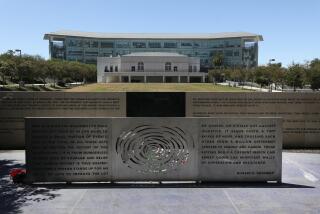The Times is blind to bulldozers flattening homes
- Share via
An occasional column in which the Times invites outside critics to implode a Southern California newspaper that made Barbra Streisand write an angry letter.
**
DID YOU KNOW that the Los Angeles Unified School District recently voted to bulldoze more than 50 working-class residences in Echo Park to build an elementary school, even though there’s nonresidential property sporting “For Sale” signs just a few hundred yards down the street?
Not if you get your news from the Los Angeles Times. The hometown paper, whose offices sit less than three miles away, has not (according to my LexisNexis searches) published a single word on the controversy -- not about the proposal, not about the community meetings, not about the school board vote (6 to 0, by the way, with Jose Huizar absent, perhaps because he was too busy campaigning for City Council on a platform of “affordable housing”) ... and not about the protest lawsuit being prepared by a group called the Right Site Coalition.
This is not just some one-time oversight. The paper has consistently failed to cover the property-seizing excesses of the school district’s historic building boom, even in long features about
I certainly don’t expect or even want Spring Street’s reporters and editors to share my own preoccupations with eminent domain. But I do think it’s reasonable to expect at least one affected homeowner, or property-rights enthusiast, to be quoted when the paper devotes long articles to what staff writer Cara Mia DiMassa described as possibly “the largest public works project in the western United States.”
DiMassa’s 1,800-worder in November 2004 did include the newsworthy data that “about 1,200 families and 400 businesses have been displaced so far,” and that the school district has “paid out $38.8 million in moving and relocation expenses to families and businesses forced to move” (numbers that have not been updated in the paper since), but the only hint of controversy was a squib about how the “strategy has had mixed results.” In fact, her article stated at face value that “though the district avoided taking large numbers of homes in the first building phase, officials say they probably won’t have that luxury for much longer.”
Six months earlier, a freelancer went even further than equating an alleged reluctance to take people’s homes to “luxury” -- his 1,400 words of critic-free prose actually described the school-construction frenzy as “a boon to property owners.” As for those property owners who don’t consider a forced sale and relocation a “boon,” the freelancer wrote: “Although the use of eminent domain acquisitions has drawn criticism from some, the district hopes benefits to remaining residents will outweigh the negatives.” These “some” were never heard from; the next paragraph was an upbeat quote from a district official.
I don’t mean to single out DiMassa, whose work I enjoy (she wrote a particularly valuable story back in February about how Huizar raised more than $330,000 in campaign money, “much of it from the building trades,” even though he was running for reelection to the school board unopposed). It’s their editors who should be demanding skeptical analysis -- and more important, a sense of basic human storytelling -- when a construction program compared in The Times to the Big Dig destroys neighborhoods in order to educate them.
There’s a great and fundamental civic drama unfolding in Echo Park and the rest of the city. It’s worth covering in The Times. Who knows? Maybe reporters could even work the phrase “eminent domain” into one of their articles. There’s a first time for everything.
More to Read
Sign up for Essential California
The most important California stories and recommendations in your inbox every morning.
You may occasionally receive promotional content from the Los Angeles Times.










